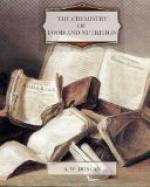Many popular writers have divided foods into flesh-formers, heat-givers, and bone-formers. Although attractive from its simplicity, this classification will not bear criticism. Flesh-formers are also heat-givers. Only a portion of the mineral matter goes to form bone.
Class I.—Inorganic compounds.
Sub-class 1. Water. 2. Mineral
Matter or Salts.
Class ii—organic compounds.
1. Non-Nitrogeneous or Ternary Compounds.
a Carbohydrates.
b Oils. c Organic
Acids.
2. Nitrogenous Compounds. a
Proteids. b Osseids.
Class III.—NON-NUTRITIVES, FOOD ADJUNCTS
AND DRUGS.
Essential Oils, Alkaloids, Extractives,
Alcohol, &c.
These last are not strictly foods, if we keep to the definition already given; but they are consumed with the true foods or nutrients, comprised in the other two classes, and cannot well be excluded from consideration.
Water forms an essential part of all the tissues of the body. It is the solvent and carrier of other substances.
Mineral Matter or Salts, is left as an ash when food is thoroughly burnt. The most important salts are calcium phosphate, carbonate and fluoride, sodium chloride, potassium phosphate and chloride, and compounds of magnesium, iron and silicon.
Mineral matter is quite as necessary for plant as for animal life, and is therefore present in all food, except in the case of some highly-prepared ones, such as sugar, starch and oil. Children require a good proportion of calcium phosphate for the growth of their bones, whilst adults require less. The outer part of the grain of cereals is the richest in mineral constituents, white flour and rice are deficient. Wheatmeal and oatmeal are especially recommended for the quantity of phosphates and other salts contained in them. Mineral matter is necessary not only for the bones but for every tissue of the body.
When haricots are cooked, the liquid is often thrown away, and the beans served nearly dry, or with parsley or other sauce. Not only is the food less tasty but important saline constituents are lost. The author has made the following experiments:—German whole lentils, Egyptian split red lentils and medium haricot beans were soaked all night (16 hours) in just sufficient cold water to keep them covered. The water was poured off and evaporated, the residue heated in the steam-oven to perfect dryness and weighed. After pouring off the water, the haricots were boiled in more water until thoroughly cooked, the liquid being kept as low as possible. The liquid was poured off as clear as possible, from the haricots, evaporated and dried. The ash was taken in each case, and the alkalinity of the water-soluble ash was calculated as potash (K_{2}O). The quantity of water which could be poured off was with the German lentils, half as much more than the original weight of the pulse; not quite as much could be poured off the others.




